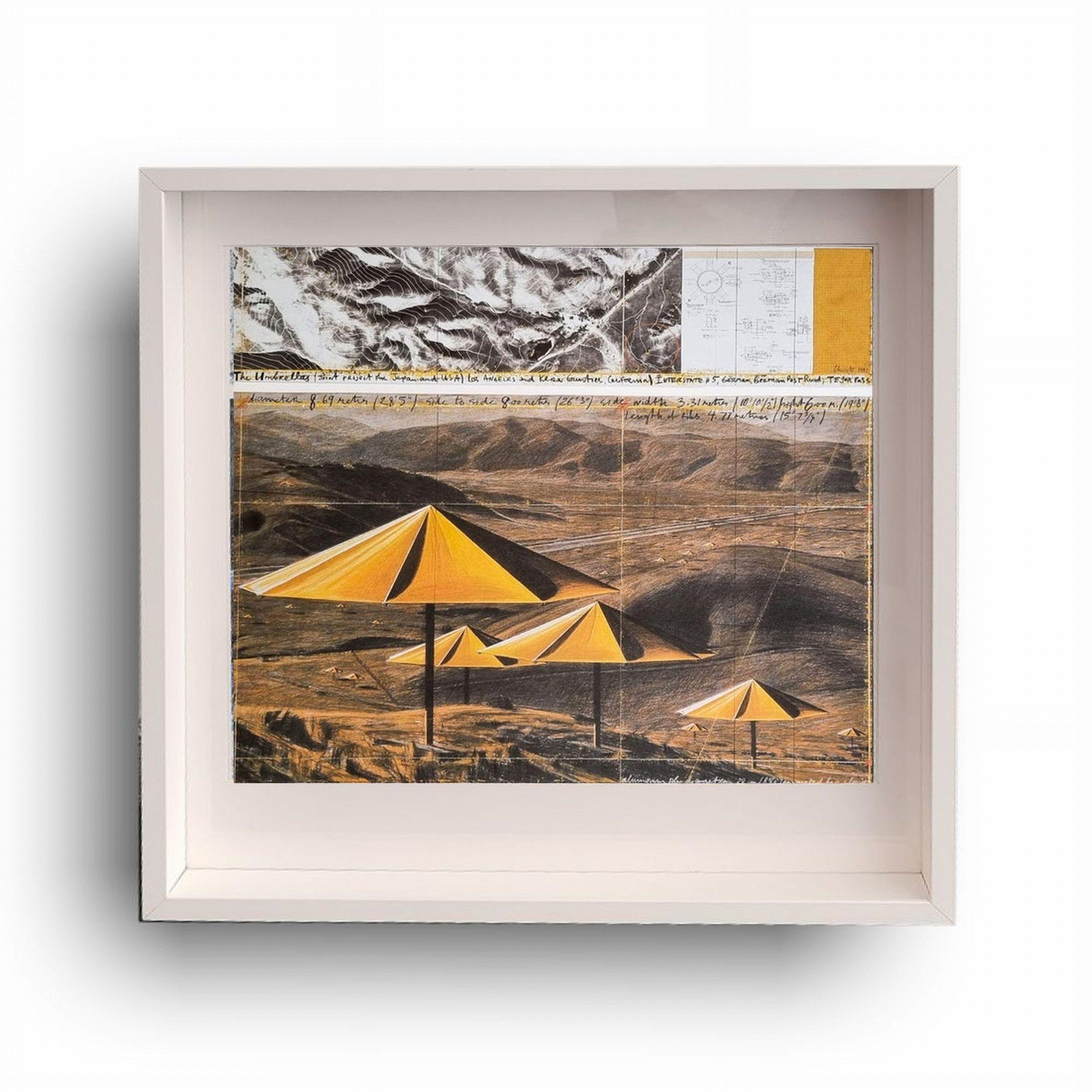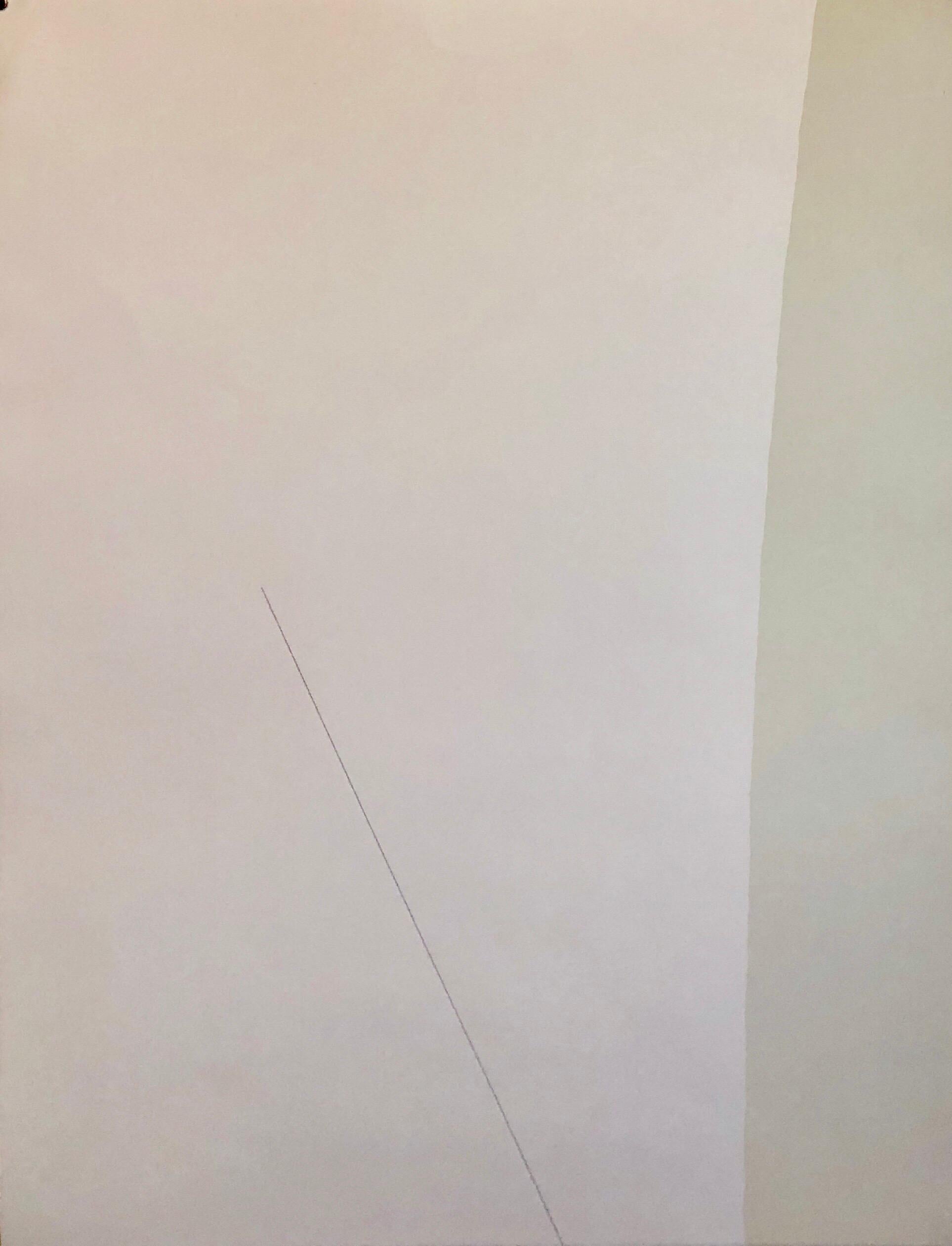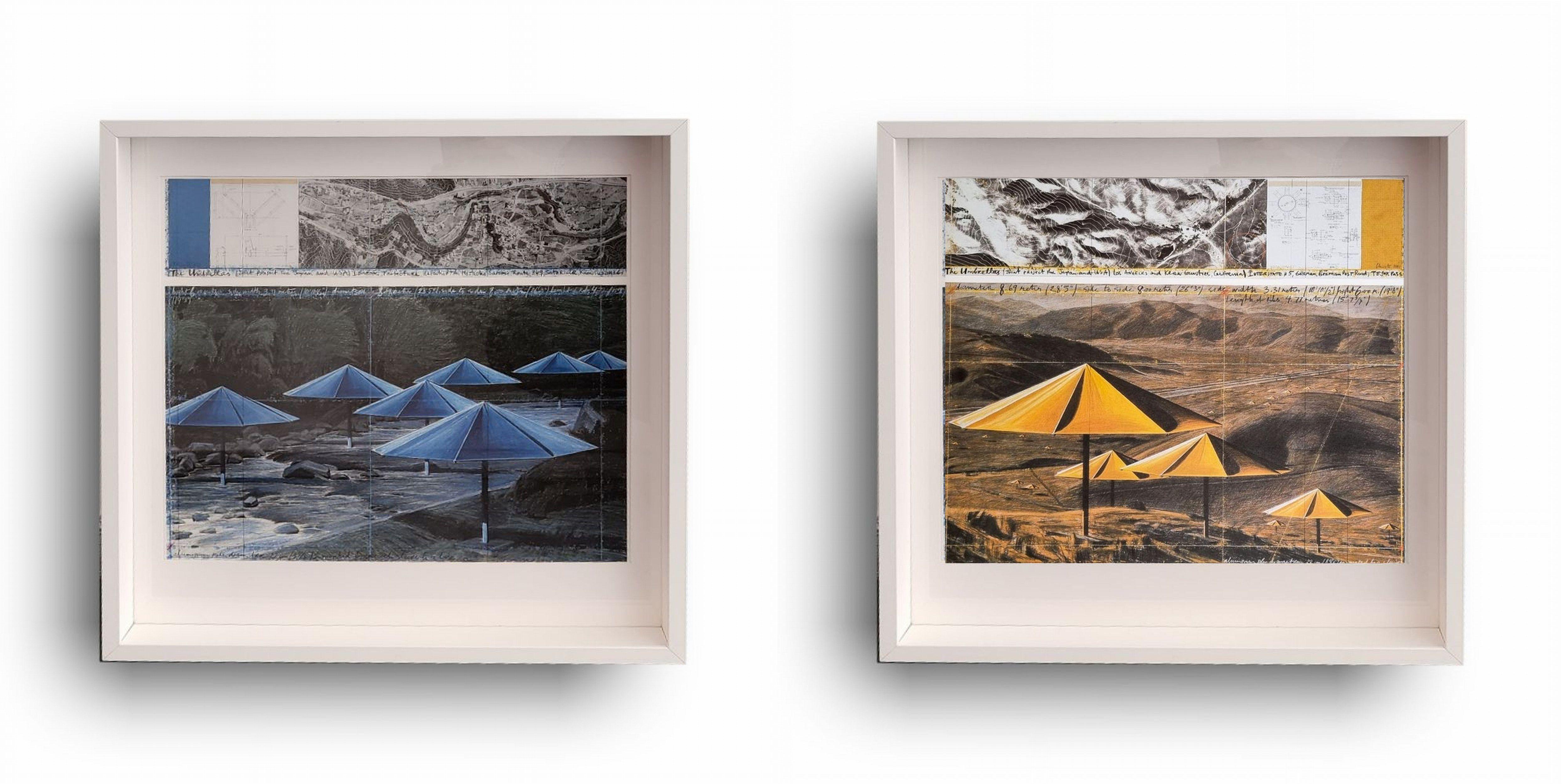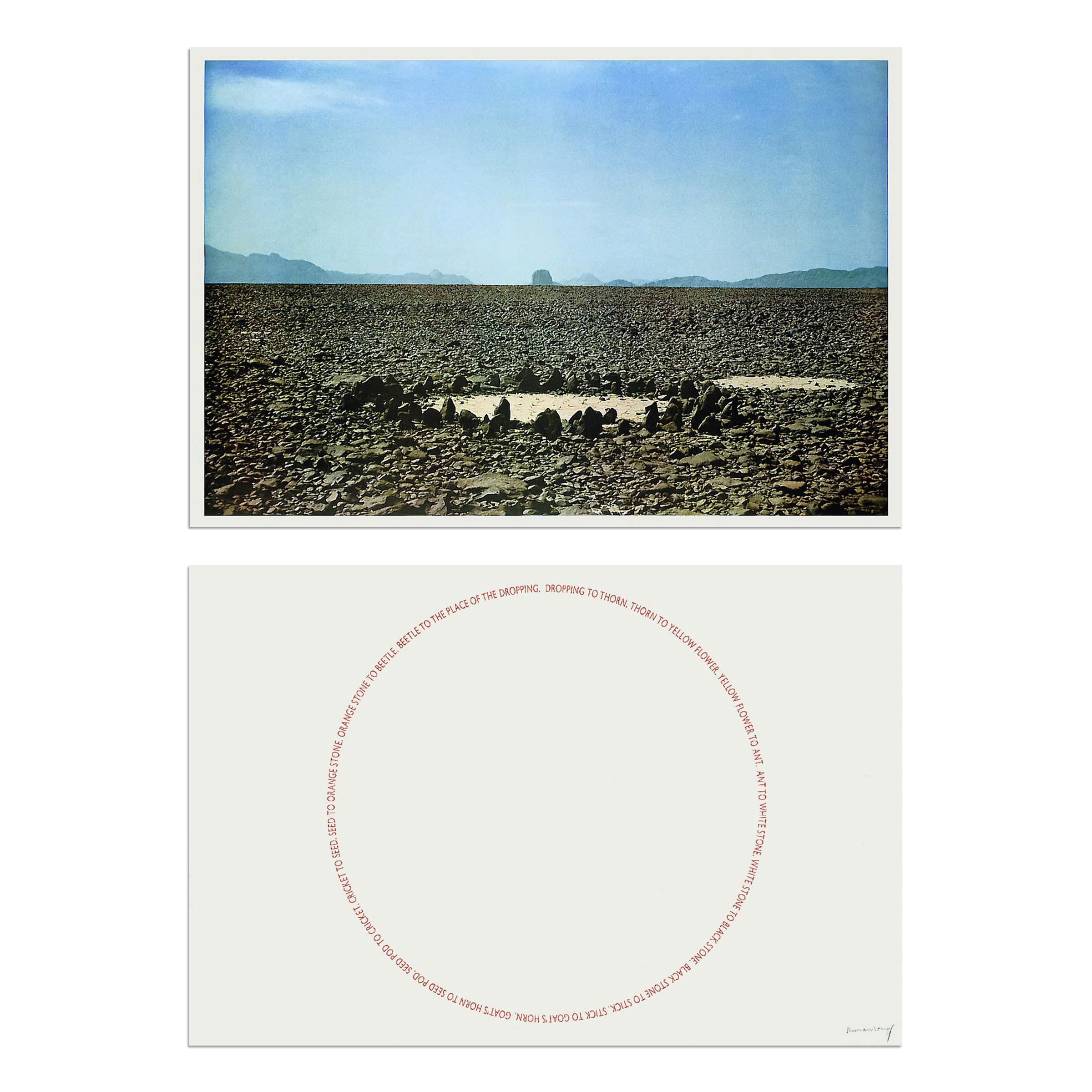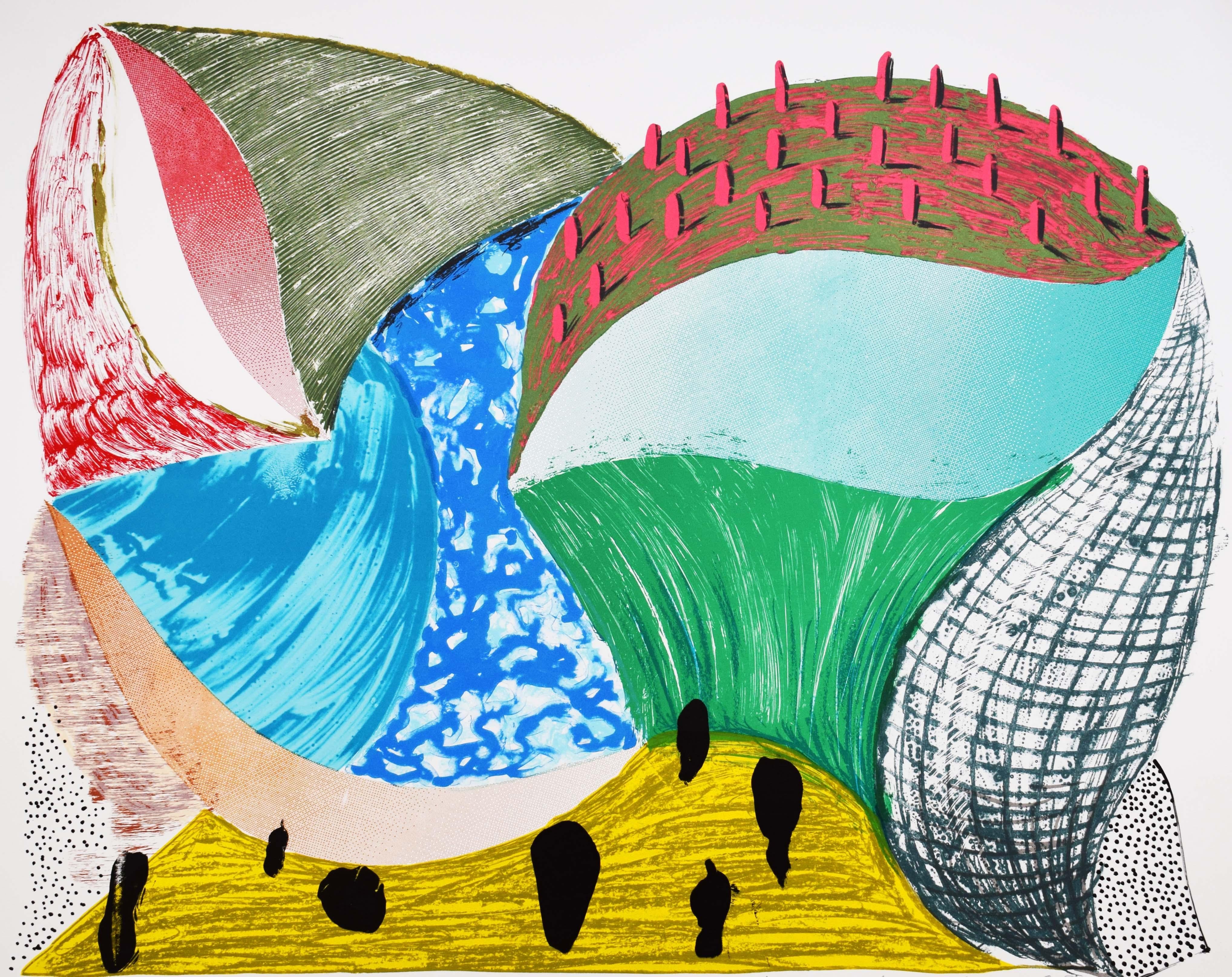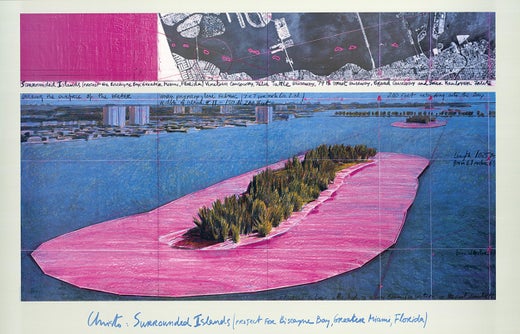Christo and Jeanne-ClaudeThe Umbrellas (Blue) (FRAMED - BLACK OR WHITE - YOU CHOOSE - FREE US SHIPPING)1991
1991
About the Item
- Creator:Christo and Jeanne-Claude (1935 - 2020, Bulgarian, Moroccan, American)
- Creation Year:1991
- Dimensions:Height: 20.5 in (52.07 cm)Width: 20.5 in (52.07 cm)Depth: 2.5 in (6.35 cm)
- Medium:
- Movement & Style:
- Period:
- Condition:
- Gallery Location:Kansas City, MO
- Reference Number:
Christo and Jeanne-Claude
Motivated solely by a mission to spread joy and celebrate beauty through their work, Christo and Jeanne-Claude (1935–2020; 1935–2009) created riveting large-scale public art installations that pushed ephemeral art to an entirely unprecedented new level. While the pair created prints, photography and a range of other types of art, they’re best known for their installations — working with a combination of textiles and industrial materials, Christo and Jeanne-Claude created colossal site-specific sculptures and other projects that frequently included wrapping monuments, walkways and even coastlines in reams of fabric in order to draw attention and encourage viewers to experience familiar objects and places in entirely new ways.
Christo and Jeanne-Claude frequently incorporated nature’s forces into their works, creating billowing fence lines, enormous inflatable free-standing structures and colorful floating walkways. Partners in life and art, the pair designed installations that often took years or even decades to realize and lasted for only days or weeks. Christo and Jeanne-Claude’s preparatory works and detailed drawings and collages are today a testament to their intricate ephemeral masterpieces and legacy.
Christo and Jeanne-Claude’s stories, incredibly, began on the exact same day — on June 13, 1935, Christo Vladimirov Javacheff was born in Gabrovo, Bulgaria, and on the very same day in Casablanca, Morocco, Jeanne-Claude Denat de Guillebon was born. While Jeanne-Claude received a broad education and a baccalauréat in Latin and philosophy, growing up in France, Switzerland, Morocco and Tunisia, Christo studied art from the age of six years old. He went on to study painting, drawing, architecture and sculpture at the National Academy of Art in Sofia before leaving Bulgaria to escape the Hungarian Revolution.
Christo spent time in Prague before a brief stint at the Vienna Academy of Fine Arts, moving on then to Geneva and ultimately France. He made money by painting portraits for wealthy families. After being hired by Jeanne-Claude’s mother to paint three portraits of her, Christo met his future wife and collaborator. The pair created their first environmental installation, Dockside Packages and Stacked Oil Barrels, in 1961.
Together, Christo and Jeanne-Claude pursued increasingly ambitious projects, proposing to wrap everything from trees in Wrapped Trees, Foundation Beyeler and Berower Park, Riehen, Switzerland, 1997-98 to important public buildings including the Wrapped Reichstag, Berlin, 1971–95. They also created free-standing abstract sculptures such as the 5,600 Cubicmeter Package, billowing curtains such as Valley Curtain, Rifle, Colorado, 1970–72, and proposed installations in locations as far-flung as Dubai and Japan. These projects and others have been linked to the Pop art-adjacent nouveau réalisme movement.
Classically trained in drawing, Christo created preparatory sketches and collages for the projects, selling his artwork to independently fund the monumental temporary installations the pair erected. Meanwhile, Jeanne-Claude advocated for the pair’s artwork, speaking at public forums, sending proposals to municipal governments, and using her unique combination of compelling charm and stoic stubbornness to get their projects approved.
Devoted to their ideals of spreading joy and beauty, the pair accepted no commissions or commercial collaborations — all their installations were funded purely by the sale of their preparatory art. The last of their realized urban works, that 2005 project invited New Yorkers to go for a glorious walk through 7,503 saffron-fabric-draped portals along the pathways of Central Park. More than 4 million people did.
Christo’s wrapped sculptures, which he began making early in his career, as well as his preparatory works, are held in the permanent collections of museums and other institutions including the Smithsonian American Art Museum, the National Gallery of Art, the Museum of Contemporary Art and the Centre Pompidou. Jeanne-Claude died in 2009, and Christo continued to realize the pair’s planned projects until his own passing in 2020.
Find original Christo and Jeanne-Claude photography, mixed media works, sculptures and prints on 1stDibs.
- ShippingRetrieving quote...Ships From: Kansas City, MO
- Return PolicyA return for this item may be initiated within 7 days of delivery.
- The Umbrellas (Yellow) (FRAMED - BLACK OR WHITE - YOU CHOOSE - FREE US SHIPPING)By Christo and Jeanne-ClaudeLocated in Kansas City, MOChristo The Umbrellas (Yellow) (FRAMED - either black or white frame - you choose) Lithoserigraph Year: 1991 Size: 14.6 × 16.4 on 19.1 × 19.9 inches Framed: 20.5 x 20.5 x 2.5 inches ...Category
1990s Modern Landscape Prints
MaterialsLithograph, Screen
- The Umbrellas (BOTH FRAMED - BLACK OR WHITE ... YOU CHOOSE + FREE U.S. SHIPPING)By Christo and Jeanne-ClaudeLocated in Kansas City, MOCOULD ALSO BE FRAMED IN A BLACK FRAME - SAME SIZE & MODEL Christo The Umbrellas (Yellow & Blue) Lithoserigraphs Year: 1991 Size: 14.6 × 16.4 on 19.1 × 19.9 inches (EACH) Framed: 20....Category
1990s Modern Landscape Prints
MaterialsLithograph, Screen
- Untitled Landscape IIBy Claudia KellerLocated in Kansas City, MOClaudia Keller Untitled Landscape II Color Silkscreen Year: 1985 Signed, dated, numbered or inscribed Edition: 180 Size: 19.5 × 18.5 on 27.3 × 23.4 in...Category
1980s Modern Prints and Multiples
MaterialsScreen
- La Barque Echouee (Mourlot, Paris)By Andre MinauxLocated in Kansas City, MOAndre Minaux La Barque Echouee 1964 Original Color Lithograph on Velin d'Arches Size: 10x7.375in Edition: 2,000 Annotated verso Unsigned as issued Publisher: Mourlot, Paris Printer: ...Category
1960s Modern Prints and Multiples
MaterialsLithograph, Vellum
- The Wall-Wrapped Roman Wall, Rome, 1974 (Installation, Public Art, Wrapped Art)By Christo and Jeanne-ClaudeLocated in Kansas City, MOChristo & Jeanne Claude The Wall-Wrapped Roman Wall, Rome, 1974 Offset Lithograph After a photograph by Foto Harry Shunk, 1974 Size: 25.2×37.4in Pub...Category
1970s Modern Landscape Prints
MaterialsOffset, Lithograph
- La Seine a Paris (75% OFF LIST PRICE FOR A LIMITED TIME, FRAMING OPTIONS AVAIL)By Richard FlorsheimLocated in Kansas City, MORichard Florsheim La Seine a Paris 1964 Original Color Lithograph on Velin d'Arches Size: 10x7.375in Edition: 2,000 Annotated verso Unsigned as issued Publisher: Mourlot, Paris Print...Category
1960s Modern Prints and Multiples
MaterialsLithograph, Vellum
- Michael Gross Israeli Minimalist Conceptual Art, Abstract Jerusalem SilkscreenBy Michael GrossLocated in Surfside, FLMichael Gross (Hebrew: מיכאל גרוס; 1920 – 4 November 2004) was an Israeli painter, sculptor and conceptual artist. Michael Gross was born in Tiberias in the British-administered Palestine in 1920. He grew up in the farming village of Migdal. In 1939-1940, he left to study at the Teachers’ Training College in Jerusalem. In 1939, while he was away, his father was murdered by Arabs, and the family farm and home were destroyed. This event impacted on his work as an artist. From 1943 to 1945, he studied architecture at Technion – Israel Institute of Technology in Haifa. From 1951 to 1954, he studied art at the École nationale supérieure des Beaux-Arts in Paris. He returned to Israel in 1954 and settled in the artists’ village of Ein Hod. Gross's works are imbued with the light and spirit. They are minimalist, but never pure abstraction, always tied to natural form and laden with feeling. In his early paintings, Gross simplified form in order to concentrate on proportion, broad areas of color, and the size and placement of each element. This reductive process was also notable in his sculptures, whether in painted iron or other materials such as white concrete. In later paintings, he often juxtaposed large off-white panels with patches of tone, adding textured materials such as wooden beams, burlap and rope. Gross’s rough, freely-brushed surfaces, along with the use of soft pastel coloring, conjure up images of the Israeli landscape. Education 1936-1940 Teachers Seminary, Jerusalem 1943-1945, Technion, Haifa, architecture, studied sculpture with Moshe Ziffer. 1951-1954 Beaux Arts, Paris with Michel Guimond Teaching 1954 - 1954 Higher School of Education, Haifa. 1957-1960 Bezalel Academy of Arts and Design, Jerusalem 1960-1980 Oranim Art Institute, Tivon Awards 1964: Hermann Struck Prize 1967: Dizengoff Prize 1971...Category
1970s Modern Landscape Prints
MaterialsLithograph, Screen
- 1959 Israeli Moshe Tamir Color Modernist Mixed Media Serigraph PhoenixBy Moshe TamirLocated in Surfside, FLAbstract Composition, 1959 Silkscreen Lithograph "Phoenix". This was from a portfolio which included works by Yosl Bergner, Menashe Kadishman, Yosef Zaritsky, Aharon Kahana, Jacob Wexler...Category
1950s Modern Abstract Prints
MaterialsLithograph, Screen
- Richard Long, Two Sahara Works - Set of 1 Grano Lithograph and 1 SilkscreenBy Richard LongLocated in Hamburg, DERichard Long (British, b. 1945) Two Sahara Works, 1988 Medium: Set of 1 grano lithograph and 1 silkscreen, on rag paper Dimensions: each 63 x 93 cm (24¾ x 36½ in) Edition of 75: each...Category
20th Century Land Figurative Prints
MaterialsLithograph, Screen
- Gorge d’Incre, from: Some More New Prints - British Contemporary LandscapeBy David HockneyLocated in London, GBThis original lithograph and screenprint in colours is hand signed in pencil by the artist "Hockney" in the lower right image. It is also dated ‘93’ [1993] next to the signature. It ...Category
1990s Contemporary Landscape Prints
MaterialsLithograph, Screen
- Israeli Naive Art Screen Print Lithograph Jerusalem, Sanhedrin Old City Folk ArtBy Gabriel CohenLocated in Surfside, FLBold color lithograph, hand signed in pencil and numbered AP IX/X (artist’s proof 9/10), Jerusalem Print Workshop blind stamp lower right. On French Arches paper. Gabriel Cohen, Self taught, Naive painter was born in Paris in 1933, to parents from Jerusalem with a father who studied the kabbalah. Throughout World War II, the family hid from the Nazis in Paris. Images of Nazi soldiers appear in several of his paintings. In 1949, when Gabriel was 16, the family returned to Israel. They managed to save enough money to move back to the quarter where both parents were born: Ohel Moshe in Nachlaot. Gabriel served in the artillery corps and after the army, went back to live in his parents' house and earned a living polishing diamonds. The head of the polishing plant, who noticed his employee's artistic skill, allowed him to paint during work hours. He once asked Cohen if he could draw a tiger. Cohen drew him a tiger. And he did a lot of sculpting and painting on glass. He also loved to play the guitar, especially flamenco style. Critics say he is one of Israel's greatest naive-style painters. Along with Shalom of Safed, Kopel Gurwin and Natan Heber, He is renowned as one of Israel's greatest living naive-style folk art painters, recipient of the Jerusalem Prize for Art (1987), a permanent entry in encyclopedias of naive painting, who exhibited his work not only in Israel, but also in Paris, Venezuela, Denmark and Germany; the same Gabriel Cohen whose colorful , bold paintings were exhibited at the Jewish Museum in New York in 1987 alongside works by Marc Chagall; the same Gabriel Cohen about whom curator and art scholar Gideon Ofrat says, "There is no questioning his greatness." He has shown in Paris on the Rue de Rosiers in the Marais. His impressions of his journeys, mostly imaginary, yet some real, are expressed in Cohen's paintings. Huge, colorful canvases rich in precise detail and fantasy, in which he paints the Eiffel Tower and the Russian steppes or the vistas of Paris and the Tower of Babel "In my opinion, it's also because the Tower of Babel has some kind of phallic, erotic meaning, but also because of the internationalism, of the mixture and confusion of nations, which is an essential element in Gabi Cohen's work," says Gideon Ofrat. There is no superlative that has not been lavished on Cohen's work by art critics, since he began showing his paintings at age 40, All the art critics seemed to agree at once that Cohen is one of the greatest naive-style painters in Israel. Their counterparts abroad seconded this view. About a year and a half ago, Zadka organized a show for Cohen at the Jerusalem Artists' House. The Tel Aviv Museum bought a painting of Gabi's and so did the Israel Museum, and several artists bought his drawings. He is a great, great painter. There is no painter who is more of a symbolist and illustrative artist than he is. As a painter myself, I admire him." The Yom Kippur War in 1973 sparked an artistic breakthrough for Cohen; it was at that time that he began to sit on the sidewalk after his work as a diamond polisher and paint. Not long afterward, in early 1974, he did a painting he called "Moses on the Mountain." Ruth Debel, of the Debel Gallery in Ein Kerem, passed by and saw it on the street. She asked how much he wanted for it, and for the first time in his life, he realized that his work had financial value. His first show was at the Debel Gallery in 1974. The response was overwhelming. Cohen was immediately declared a genius. His paintings at the gallery were purchased and he continued to create new paintings. That same year, he was invited to take part in a group exhibition of naive artists at the Kunsthaus in Zurich, and a year later, his work was included in a traveling show of naive-style artists from Israel that was exhibited in Denmark and Germany. Soon after that he was invited to be part of group shows in Venezuela and at the Tel Aviv Museum. Cohen had four solo shows at the Debel Gallery. Awards And Prizes 1987 Jerusalem Prize for Painting and Sculpture 1999 Shoshana Ish-Shalom Prize for special contribution to art, Jerusalem He has exhibited alngside all of the Israeli great artists. including Naive Art Group exhibition Gvanim Art Gallery, Jerusalem Rubin, Rachel Roman, Yitzhak Zarembo, Leah Moscovitz, Shalom (of Safed) Steinberg, Michael Danisov, Salva Harbon, Haim Cohen, Gabriel Chanannia, Joseph (Jojo) Local Hero...Category
20th Century Folk Art Landscape Prints
MaterialsScreen, Lithograph
- Pop Art Aspen Road Sign D'arcangelo Silkscreen Chiron Press Vintage Art PosterLocated in Surfside, FLAllan D'Arcangelo (American/New York, 1930-1998), "Aspen Center of Contemporary Art", 1967 silkscreen, hand signed in pencil, dated, numbered "45/200" and blind stamped "Chiron Press, New York, NY" 32 in. x 24 in. Allan D'Arcangelo (1930-1998) was an American artist and printmaker, best known for his paintings of highways and road signs that border on pop art and minimalism, precisionism, Abstract illusionism and hard-edge painting, and also surrealism. His subject matter is distinctly American and evokes, at times, a cautious outlook on the future of this country. Allan D'Arcangelo was the son of Italian immigrants. He studied at the University of Buffalo from 1948–1953, where he got his bachelor's degree in history. After college, he moved to Manhattan and picked up his studies again at the New School of Social Research and the City University of New York, City College. At this time, he encountered Abstract Expressionist painters who were in vogue at the moment. After joining the army in the mid 1950s, he used the GI Bill to study painting at Mexico City College from 1957–59, driving there over 12 days in an old bakery truck retrofitted as a camper. However, he returned to New York in 1959, in search of the unique American experience. It was at this time that his painting took on a cool sensibility reminiscent of Roy Lichtenstein and Andy Warhol. His interests engaged with the environment, anti-Vietnam War protests, and the commodification and objectification of female sexuality. D'Arcangelo first achieved recognition in 1962, when he was invited to contribute an etching to The International Anthology of Contemporary Engraving: America Discovered; his first solo exhibition came the next year, at the Thiebaud Gallery in New York City. In 1965 he contributed three screenprints to Original Edition's 11 Pop Artists portfolio. By the 1970s, D'Arcangelo had received significant recognition in the art world. He was well known for his paintings of quintessentially American highways and infrastructure, and in 1971 was commissioned by the Department of the Interior to paint the Grand Coulee Dam in Washington state. However, his sense of morality always trumped his interest in art world fame. In 1975, he decided to quit the gallery that had been representing him for years, Marlborough Gallery, because of the way they handled Mark Rothko legacy. D'Arcangelo rejected Abstract Expressionism, though his early work has a painterly and somewhat expressive feel. He quickly turned to a style of art that seemed to border on Pop Art and Minimalism, Precisionism and Hard-Edge painting. Evidently, he didn't fit neatly in the category of Pop Art, though he shared subjects (women, signs, Superman) and techniques (stencil, assemblage) with these artists.He turned to expansive, if detached scenes of the American highway. These paintings are reminiscent of Giorgio de Chirico-though perhaps not as interested in isolation-and Salvador Dali-though there is a stronger interest in the present and disinterest in the past. These paintings also have a sharp quality that is reminiscent of the precisionist style, or more specifically, Charles Sheeler. 1950s, Before D'Arcangelo returned to New York, his style was roughly figurative and reminiscent of folk art. During the early 1960s, Allan D'Arcangelo was linked with Pop Art. "Marilyn" (1962) depicts an illustrative head and shoulders on which the facial features are marked by lettered slits to be "fitted" with the eyebrows, eyes, nose and mouth which appear off to the right in the composition. In "Madonna and Child," (1963) the featureless faces of Jackie Kennedy and Caroline are ringed with haloes, enough to make their status as contemporary icons perfectly clear. Select Exhibitions: Fischbach Gallery, New York, Ileana Sonnabend Gallery, Paris, Gallery Müller, Stuttgart, Germany Hans Neuendorf Gallery, Hamburg, Germany Dwan Gallery...Category
1960s Pop Art Abstract Prints
MaterialsLithograph, Screen
